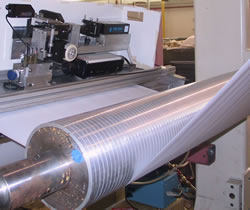|
|
 |
BERKELEY, CA -- Hoping to save the paper manufacturing
industry millions of dollars in energy costs, Lawrence Berkeley National
Laboratory (LBNL) and Institute of Paper Science & Technology (IPST)
engineers have developed a laser ultrasonic sensor that measures paper's
flexibility as it courses through a production web at up to 65 miles per
hour. The project's principal investigators are Rick Russo (LBNL) and
Chuck Habeger (IPST).
"We're measuring the elastic properties of paper at manufacturing
speeds using a noncontact, nondestructive monitor," says Paul Ridgway
of Berkeley Lab's Environmental Energy Technologies Division.
 |
|
 |
|
| The Berkeley Lab laser ultrasonic sensor's
successful Mead Paper Company field test paves the way for a full-scale
mill trial in the summer of 2003. |
|
Last summer, Ridgway, Russo and IPST engineers tested the laser ultrasonic
sensor at a Mead Paper Company mill in Ohio. They installed the sensor
on a pilot paper coating machine and ran six paper grades through the
web press, ranging from copy paper to heavy linerboard. The sensor's signals
remained excellent even at paper speeds up to 5,000 feet per minute, and
the laser didn't damage the paper. The effects of the papers' moisture,
tension, basis weight, and speed on the measurements were also examined.
"The Mead test demonstrated the instrument works in an industrial
setting," Ridgway says. "It's a successful step toward a mill
trial on a paper-making machine in which the environment will be much
harsher. It will be hotter and wetter, and there will be more vibrations
and fiber debris in the air."
The sensor is part of Industries of the Future, a research and development
collaboration between the Department of Energy's Office of Industrial
Technologies (OIT) and several industries to improve energy and resource
efficiency. Under this program, the American Forest and Paper Association
created Agenda 2020, which outlines the forest products industry's goals
and research priorities. To understand how the sensor contributes to this
initiative, consider how paper is currently evaluated. After it's manufactured,
a small sample of a three-ton paper roll is manually analyzed for its
mechanical properties by observing how it bends. If the sample doesn't
meet specifications, the entire roll is scrapped or sold as an inferior
grade. To avoid this costly mistake, manufacturers often over engineer
paper, erring on the side of caution and using more pulp than necessary
to ensure the final product isn't substandard. Not only does this consume
more raw materials, it consumes more energy: the more pulp used per unit
of paper, the more heat is required during the drying phase, which even
in the most efficient mills requires an enormous amount of energy.
Rather than rely on postproduction evaluation and hope for the best,
the team has developed a sensor that measures flexibility on the fly,
in real time. It also conducts the measurements without touching the paper,
an important advantage given that at 30 meters per second the slightest
contact can mar lightweight grades such as copy paper and newsprint. This
represents an improvement over contact transducers, another real-time
evaluation tool that measures paper's tensile elasticity by placing an
ultrasound head directly onto the paper as it's coursing through the web.
Because it touches the paper, this technique can only be used with thicker
stock.
In rough terms, the sensor measures the time it takes ultrasonic shock
waves to propagate from a laser-induced excitation point to a detection
point only millimeters away. The velocity at which the ultrasound waves
travel from the ablation point through the paper to the detection point
is theoretically related to two elastic properties, bending stiffness
and out-of-plane shear rigidity.
More specifically, a detection beam from a commercially available Mach-Zender
interferometer is directed toward a quickly rotating mirror. As the mirror
spins, the beam is reflected in a circular pattern much like a lighthouse's
beam. During a portion of each revolution, the beam meets the paper as
it courses along the production belt and remains with the paper until
the beam's arc leaves the paper's plane. Think of the lighthouse beam
momentarily tracking a speedboat as it races parallel to shore. Because
both the beam and the paper are moving at the same speed, the detection
beam remains on the same point on the paper throughout their brief contact.
An optical encoder determines when the detection beam is perpendicular
to the paper, at which time a specially designed adjustable delay circuit
fires the pulsed neodymium-yttrium-aluminum-garnet laser. This nanosecond
pulse causes a microscopic thermal expansion or ablation on the paper,
which is too small to mar the paper and effect how it absorbs ink, but
strong enough to send ultrasonic shock waves through the sheet. The waves
propagate through the paper until they're registered by the detection
beam. Because the laser is synchronized to only fire when the detection
beam is perpendicular to the paper, the distance between the ablation
point and detection point is known, and the waves' speed is calculated.
A full-scale pilot test of the laser ultrasonic sensor is scheduled for
the summer of 2003. Further in the future, the sensor could provide quality-control
safeguards and real-time process information for feedback control in any
manufacturing process involving thin, moving sheets such as metals, plastics,
polymeric materials, and glasses.
Berkeley Lab is a U.S. Department of Energy national laboratory located
in Berkeley, California. It conducts unclassified scientific research
and is managed by the University of California.
|

